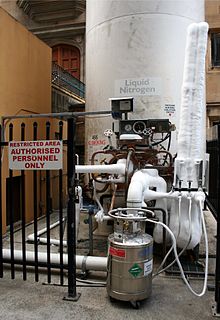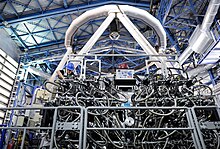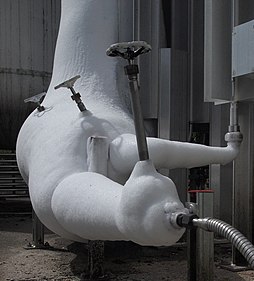Cryogenics


In physics, cryogenics is the production and behaviour of materials at very low temperatures.
The 13th
Discovery of
Cryogenicists use the
Definitions and distinctions
- Cryogenics
- The branches of engineering that involve the study of very low temperatures (ultra low temperature i.e. below 123 K), how to produce them, and how materials behave at those temperatures.
- Cryobiology
- The branch of biology involving the study of the effects of low temperatures on organisms (most often for the purpose of achieving cryopreservation). Other applications include Lyophilization (freeze-drying) of pharmaceutical[13] components and medicine.
- Cryoconservation of animal genetic resources
- The conservation of genetic material with the intention of conserving a breed. The conservation of genetic material is not limited to non-humans. Many services provide genetic storage or the preservation of stem cells at birth. They may be used to study the generation of cell lines or for stem-cell therapy.[14]
- Cryosurgery
- The branch of surgery applying cryogenic temperatures to destroy and kill tissue, e.g. cancer cells. Commonly referred to as Cryoablation.[15]
- Cryoelectronics
- The study of electronic phenomena at cryogenic temperatures. Examples include superconductivity and variable-range hopping.
- Cryonics
- Cryopreserving humans and animals with the intention of future revival. "Cryogenics" is sometimes erroneously used to mean "Cryonics" in popular culture and the press.[16]
Etymology
The word cryogenics stems from Greek κρύος (cryos) – "cold" + γενής (genis) – "generating".
Cryogenic fluids
Cryogenic fluids with their boiling point in Kelvin[17] and degree Celsius.
| Fluid | Boiling point (K) | Boiling point (°C) |
|---|---|---|
| Helium-3 | 3.19 | -269.96 |
| Helium-4 | 4.214 | -268.936 |
| Hydrogen | 20.27 | -252.88 |
| Neon | 27.09 | -246.06 |
| Nitrogen | 77.09 | -196.06 |
| Air | 78.8 | -194.35 |
| Fluorine | 85.24 | -187.91 |
| Argon | 87.24 | -185.91 |
| Oxygen | 90.18 | -182.97 |
| Methane | 111.7 | -161.45 |
Industrial applications
This section needs additional citations for verification. (March 2018) |
Liquefied gases, such as liquid nitrogen and liquid helium, are used in many cryogenic applications. Liquid nitrogen is the most commonly used element in cryogenics and is legally purchasable around the world. Liquid helium is also commonly used and allows for the lowest attainable temperatures to be reached.
These liquids may be stored in
Cryogenic barcode labels are used to mark Dewar flasks containing these liquids, and will not frost over down to −195 degrees Celsius.[18]
Cryogenic transfer pumps are the pumps used on
, as are cryogenic valves.Cryogenic processing
The field of cryogenics advanced during World War II when scientists found that metals frozen to low temperatures showed more resistance to wear. Based on this theory of
Cryogens, such as liquid
Cryogenic processing is not a substitute for heat treatment, but rather an extension of the heating–quenching–tempering cycle. Normally, when an item is quenched, the final temperature is ambient. The only reason for this is that most heat treaters do not have cooling equipment. There is nothing metallurgically significant about ambient temperature. The cryogenic process continues this action from ambient temperature down to −320 °F (140 °R; 78 K; −196 °C). In most instances the cryogenic cycle is followed by a heat tempering procedure. As all alloys do not have the same chemical constituents, the tempering procedure varies according to the material's chemical composition, thermal history and/or a tool's particular service application.
The entire process takes 3–4 days.
Fuels
Another use of cryogenics is
Russian aircraft manufacturer
Other applications

Some applications of cryogenics:
- spectrometersthat do not require cryogens. In traditional superconducting solenoids, liquid helium is used to cool the inner coils because it has a boiling point of around 4 K at ambient pressure. Cheap metallic superconductors can be used for the coil wiring. So-called high-temperature superconducting compounds can be made to super conduct with the use of liquid nitrogen, which boils at around 77 K.
- Magnetic resonance imaging (MRI) is a complex application of NMR where the geometry of the resonances is deconvoluted and used to image objects by detecting the relaxation of protons that have been perturbed by a radio-frequency pulse in the strong magnetic field. This is most commonly used in health applications.
- In large cities, it is difficult to transmit power by overhead cables, so underground cables are used. But underground cables get heated and the resistance of the wire increases, leading to waste of power. Superconductors could be used to increase power throughput, although they would require cryogenic liquids such as nitrogen or helium to cool special alloy-containing cables to increase power transmission. Several feasibility studies have been performed and the field is the subject of an agreement within the International Energy Agency.

- Cryogenic gases are used in transportation and storage of large masses of frozen food. When very large quantities of food must be transported to regions like war zones, earthquake hit regions, etc., they must be stored for a long time, so cryogenic food freezing is used. Cryogenic food freezing is also helpful for large scale food processing industries.
- Many infrared (forward looking infrared) cameras require their detectors to be cryogenically cooled.
- Certain rare blood groups are stored at low temperatures, such as −165 °C, at blood banks.
- Cryogenics technology using liquid nitrogen and CO2 has been built into nightclub effect systems to create a chilling effect and white fog that can be illuminated with colored lights.
- Cryogenic cooling is used to cool the tool tip at the time of machining in manufacturing process. It increases the tool life. Oxygen is used to perform several important functions in the steel manufacturing process.
- Many rockets and lunar landers use cryogenic gases as propellants. These include liquid oxygen, liquid hydrogen, and liquid methane.
- By freezing the automobile or truck tire in liquid nitrogen, the rubber is made brittle and can be crushed into small particles. These particles can be used again for other items.
- Experimental research on certain physics phenomena, such as spintronics and magnetotransport properties, requires cryogenic temperatures for the effects to be observed.
- Certain vaccines must be stored at cryogenic temperatures. For example, the Pfizer–BioNTech COVID-19 vaccine must be stored at temperatures of −90 to −60 °C (−130 to −76 °F). (See cold chain.)[22]
Production
Cryogenic cooling of devices and material is usually achieved via the use of liquid nitrogen, liquid helium, or a mechanical cryocooler (which uses high-pressure helium lines). Gifford-McMahon cryocoolers, pulse tube cryocoolers and Stirling cryocoolers are in wide use with selection based on required base temperature and cooling capacity. The most recent development in cryogenics is the use of magnets as regenerators as well as refrigerators. These devices work on the principle known as the magnetocaloric effect.
Detectors
There are various
For cryogenic temperature measurement down to 30 K, Pt100 sensors, a resistance temperature detector (RTD), are used. For temperatures lower than 30 K, it is necessary to use a silicon diode for accuracy.
See also
References
- ^ International Dictionary of Refrigeration, http://dictionary.iifiir.org/search.php Archived 2019-10-01 at the Wayback Machine
- ^ ASHRAE Terminology, https://www.ashrae.org/technical-resources/free-resources/ashrae-terminology
- ^ "Cryogenics is usually defined as the science and technology dealing with temperatures less than about 120 K [4,5], although this review does not adhere to a strict 120 K definition." K.D. Timmerhaus, R. Reed. Cryogenic Engineering: Fifty Years of Progress. Springer Science+Business Media LLC (2007), chapter: 1.2 The Beginning of Cryogenics, p. 7
- ^ "About Cryogenics".
In terms of the Kelvin scale the cryogenic region is often considered to be that below approximately 120 K (-153 C).
- ^ "DICHLORODIFLUOROMETHANE at Pubchem".
- ^ "PROPANE at Pubchem".
- ^ J. M. Nash, 1991, "Vortex Expansion Devices for High Temperature Cryogenics", Proc. of the 26th Intersociety Energy Conversion Engineering Conference, Vol. 4, pp. 521–525.
- ISBN 978-0-387-46896-9
- ^ Celsius, Anders (1742) "Observationer om twänne beständiga grader på en thermometer" (Observations about two stable degrees on a thermometer), Kungliga Svenska Vetenskapsakademiens Handlingar (Proceedings of the Royal Swedish Academy of Sciences), 3: 171–180 and Fig. 1.
- Facts On File, Manhattan, New York City. p. 43.
- ^ Fahrenheit temperature scale, Encyclopædia Britannica Online. 25 September 2015
- ^ "Fahrenheit: Facts, History & Conversion Formulas". Live Science. Retrieved 2018-02-09.
- ^ Evans, Nicole. "What is Cryobiology?". www.societyforcryobiology.org. Retrieved 2023-11-27.
- PMID 21566712.
- ^ "Cryosurgery to Treat Cancer". NCI. June 21, 2021. Retrieved 2023-11-27.
- ^ "Cryonics is NOT the Same as Cryogenics". Cryogenic Society of America. Archived from the original on 2 December 2018. Retrieved 5 March 2013.
- McGraw-Hill Book Company.
- ^ Thermal, Timmy. "Cryogenic Labels". MidcomData. Retrieved 11 August 2014.
- ISBN 978-0-7864-7687-9.
- ^ "Tu-155 / Tu-156". www.globalsecurity.org. Retrieved 2023-11-27.
- ^ "ESO Signs Technology Transfer Licence Agreement for Cooling System". Retrieved 11 June 2015.
- ^ "Pfizer–BioNTech COVID-19 Vaccine Vaccination Storage & Dry Ice Safety Handling". Pfizer-BioNTech. Archived from the original on 24 January 2021. Retrieved 17 December 2020.
Further reading
- Haselden, G. G. (1971), Cryogenic fundamentals, Academic Press, New York, ISBN 0-12-330550-0.


